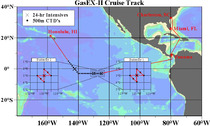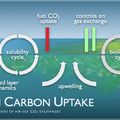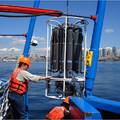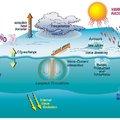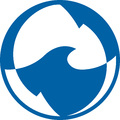GasEx 2001 Cruise
Equatorial Pacific Gas Exchange Study Cruise
The GasEx 2001 study took place aboard the NOAA Ship RONALD H. BROWN (RHB) in the Eastern Equatorial Pacific along 3°S between 125°W-130°W from 24 January to 8 March 2001. The primary objective was to use direct gas flux measurements to improve our understanding of the forcing functions on the kinetics of air-sea gas exchange. A second focus was to determine the physical, chemical, and biological factors controlling pCO2 in the surface water. The region is a CO2 source with relatively low wind speeds offering a strong contrast with the first Gas-Ex study conducted in 1998 conducted in the North Atlantic in an area of high winds and large CO2 sink.
The operations during the GasEx 2001 cruise were multi-faceted with high demands on ship's operations. A wide range of intensive over-the-side measurements were performed including: the LADAS catamaran, the ASIS platform, CARIOCA/SAMI buoy, and FSTP buoys, zodiac SMS and SPIP operations, CTD/Niskin sampling, underway seawater surface measurements and SPMR biological profiler measurements. In addition, atmospheric measurements were made using equipment mounted on the bow tower, which is aft of the jackstaff; additional atmospheric measurements were made from a bow boom.
Introduction
The world's oceans take up more than 40% of the annual release of fossil fuel carbon. To pinpoint the locations of oceanic uptake, and more importantly, to assess if this uptake will change in the future it is imperative to understand the processes responsible for this uptake. In addition to the value of knowing the CO2 sequestration by the oceans for predicting future atmospheric CO2 levels, the oceanic uptake together with the atmospheric growth rate and fuel emissions offer a robust constraint on terrestrial fluxes. Due to the spatial and temporal variability of terrestrial fluxes they are particularly difficult to quantify.
The air-sea flux of CO2, Fco2 can be expressed as:
Fco2 = k s DpCO2 (1)
where k is the gas transfer velocity, s is the solubility of CO2 that is well quantified as a function of temperature and salinity, and DpCO2 is the difference in partial pressure of CO2 between the ocean, pCO2w and the atmosphere, pCO2a. The gas transfer velocity is referred to as the kinetic term and is controlled by sub-surface turbulence. It is often parameterized with wind speed but it is widely recognized that wind is not the only factor controlling k. The DpCO2 is the thermodynamic term and is controlled by an intricate interplay between physics, chemistry and biology in the upper water column. The pCO2a follows a distinct seasonal pattern that can be estimated over the ocean. The pCO2w variability on local scale is critical to interpret the CO2 flux on a mesoscale and to estimate global variability of CO2 fluxes. A long-term goal of the GasEx projects will incorporate the findings on local scale to determine global fluxes on seasonal time scales by modeling, extrapolation algorithms, and remote sensing.
In 1998, The Ocean-Atmosphere Carbon Exchange Study (OACES) of the NOAA Office of Global Programs (OGP) initiated a program of process studies to improve quantification of air-sea CO2 fluxes and gas transfer velocity. The ultimate goal of this effort is to be able to quantify transfer velocities on a regional scale from remote sensing such that, combined with regional DpCO2, global air-sea fluxes can be determined. To accomplish this goal, fluxes have to be determined at the same (hourly) time scale as the variability in environmental forcing. The mechanisms controlling DpCO2 on short time and space scales have to be determined, and the forcing functions have to be related to parameters measured by remote sensing.
The approach has been to improve and validate methods to measure gas transfer (the kinetic term) on a hourly time scale in order to facilitate relating the transfer to environmental forcing. The surface boundary forcing will be quantified and related to near field (from ship or buoy) remote sensing. Once these relationships have been established and verified for the full spectrum of environments and conditions, the remote sensing will be expanded to far field (i.e. satellite) sensing such that global estimates of gas transfer can be determined. Simultaneous studies relating gas transfer to physical, chemical and biological controls on CO2 concentrations in surface water is necessary to construct predictive models.
Both the gas transfer velocities and the surface water pCO2, are likely to be controlled by regionally distinct processes. It is thus envisioned that a series of field studies will be executed to reach our ultimate goal of quantifying CO2 fluxes on seasonal timescales over the world's oceans. The first study, Gas Ex-98 in the N. Atlantic, was a feasibility study to test if airside direct flux measurements could be reconciled with geochemical mass balance approaches on the waterside. Direct flux measurements, co-variance, gradient, and eddy accumulation, potentially offer the advantage of measuring fluxes over 30-minute time scales but are singularly difficult to execute for trace gases with relatively small fluxes.
The proposed GasEx 2001 study is slated to take place in 2001 in the Eastern Equatorial Pacific south of the Equator. The first objective will be to continue with the recent progress and use direct gas flux measurements to improve our understanding of the forcing functions of the kinetics of air-sea gas exchange. A second focus will be on the physical, chemical, and biological factors controlling pCO2 in the surface water. This will be done at two scales: local variability on time and space scales of the direct flux measurements (hour and km scale) as it affects the CO2 fluxes, and mesoscale variability and its effect on regional flux estimates. The region is a CO2 source with relatively low wind speeds, offering a strong contrast with the first study that occurred in the North Atlantic with high winds and a large CO2 sink.
The Equatorial Pacific has been a focal point for chemical and physical studies such as JGOFS and TOGA since it has a major influence on climate variability through the ENSO cycle. The questions about mesoscale CO2 dynamics in this region relate to biological versus physical control, and remote versus local influences. Near the upwelling center it appears that the patterns in pCO2 are dominated by physics while further off-axis biological control becomes more important. The pCO2 in the surface water relates directly to upwelling strength but regional fluxes are strongly influenced by remote factors such as the capping off of the upwelling system by the low salinity water advecting from the West. Diurnal heating, tropical instability waves, variations in biological productivity, and trace metal limitations on productivity may also be important.
The region is thought to play a major role in interannual variability of CO2 fluxes and atmospheric CO2 levels. A long-term observational effort is in place to measure pCO2w levels that clearly show large depressions in D pCO2 during El Niños and pCO2w values during La Niña conditions. Although our understanding of the large-scale patterns of pCO2w in the region is improving, we must also increase our understanding on a phenomenological level in order to make accurate predictions and extrapolations. Surface water variability is evident over short temporal (hours) and spatial (km) scales. Chemical enhancement of CO2 exchange might play a role in the exchange process and surfactants are an important mechanism for retarding the gas transfer process. Surfactants produced by marine phytoplankton modulate gas exchange rates across the air-sea interface. Laboratory studies have examined the links between gas transfer velocity and wind stress, detailed small-scale wave spectra, surface viscoelastic modulus and turbulence in order to improve the parameterization of the gas transfer velocity in the presence of surfactants.
The physics of the air boundary layer is different as well in the Equatorial Pacific. Cool upwelled water will cause a stable air boundary layer, invalidating the neutral boundary assumption used in simple interpretation of the air gradient work. The boundary layer stability will also affect the friction velocity and drag coefficients. Water vapor interference will be greater as the water vapor content will be almost three times as high as during the Gas Ex-98 experiment.
The questions that will be addressed for Gas Ex-2001 are a progression of recent studies:
- Can the gas transfer velocities be measured with confidence on small time scales such that its variations can be correlated to variations in environmental forcing?
- What is the small-scale physical, chemical and biological controls on surface water pCO2 and how can the controls be measured remotely?
- What physical processes control the kinetics of air-sea CO2 exchange under low wind conditions?
- How can these processes be best parameterized with the long term objective of relating them to remotely sensed products such as seasurface slope, SST, and color?
The low wind speed in the Equatorial Pacific and high DpCO2 offers a unique opportunity to directly determine the fluxes in a low turbulence environment and to elucidate the factors controlling the flux. Also of interest is the influence of surfactants controlling the CO2 flux. Several studies have strongly implicated that surfactants have a major effect on air-sea gas exchange but evidence of CO2 flux measurements simultaneously with varying surfactant concentrations on the open ocean needs to be explored. Based on previous studies it is not unreasonable to assume that gas transfer velocities could be inhibited by 50% or more by surfactants which would drastically change our estimates of equatorial CO2 outgassing. This is also the case for parameterizations with windspeed, windstress, waves and surface roughness. This effort will provide the progress in these directions.
To access the GasEx 2001 Data here.

